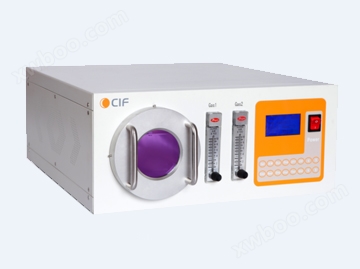400-6505-735
Plasma cleaner, also known as plasma surface treatment instrument, is a new high-tech technology that uses plasma to achieve effects that conventional cleaning methods cannot achieve. Plasma is a state of matter, also called the fourth state of matter, and does not belong to the common three states of solid, liquid and gas. Applying enough energy to the gas to ionize it will become a plasma state. The "active" components of plasma include: ions, electrons, atoms, active groups, excited nuclides (metastable state), photons, etc. Plasma cleaning machines use the properties of these active components to treat the sample surface, thereby achieving the purpose of cleaning, coating, etc.

At present, the commonly used plasma excitation frequencies are 40kHz, 13.56MHz and 2.45GHz.
The difference between 40kHz, 13.56MHz and 2.45GHz plasma excitation frequencies:
The plasma with an excitation frequency of 40kHz is ultrasonic plasma, and the reaction it undergoes is a physical reaction;
The plasma with an excitation frequency of 13.56MHz is radio frequency plasma, and the reaction it undergoes is both physical and chemical;
The plasma with an excitation frequency of 2.45GHz is microwave plasma, and the reaction it undergoes is a chemical reaction.
Application of 40kHz, 13.56MHz and 2.45GHz plasma excitation frequencies:
The plasma with an excitation frequency of 40kHz, namely ultrasonic plasma cleaning, is a plasma cleaning based on physical reactions, also called sputtering etching (SPE) or ion milling (IM). Its advantage is that it does not undergo chemical reactions itself, and no oxides will be left on the cleaned surface, which can maintain the chemical purity of the cleaned object. Ultrasonic plasma cleaning has a greater impact on the cleaned surface, so most of the actual semiconductor production applications use radio frequency plasma cleaning and microwave plasma cleaning. Ultrasonic plasma is used in surface degumming, burr grinding and other treatments with ideal results. The typical plasma physical cleaning process is to add argon gas to the reaction chamber as an auxiliary treatment plasma cleaning. Argon gas itself is an inert gas. The argon gas in the plasma does not react with the surface, but cleans the surface through ion bombardment.
Plasma with an excitation frequency of 2.45GHz, namely microwave plasma, is a typical plasma chemical cleaning process, which is oxygen plasma cleaning. The oxygen free radicals generated by plasma are very active and easily react with hydrocarbons to produce volatile substances such as carbon dioxide, carbon monoxide and water, thereby removing surface pollutants. Mainly used in scientific research and laboratories.
Plasma cleaning with an excitation frequency of 13.56MHz is a surface reaction mechanism in which both physical and chemical reactions play an important role, namely reactive ion corrosion or reactive ion beam corrosion. The two cleaning methods can promote each other. Ion bombardment damages the surface to be cleaned, weakens its chemical bonds or forms an atomic state, which is easy to absorb reactants. Ion collision heats the cleaned object, making it easier to react.
Currently, the main products of CIF in the United States are plasma cleaning machines with excitation frequencies of 40kHz and 13.56MHz. For more product information, please refer to CIF's official website: www.cif-china.com
About Us
Introduction Culture History HonorNews
News Article VideoService
After-sale ServiceNavigation
ProductsSolutionContact Us 400-6505-735
400-6505-735 CIF WeChat Service Account
CIF WeChat Service Account
 CIF Tiktok
CIF Tiktok